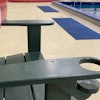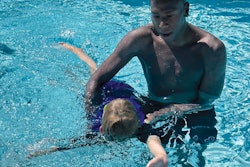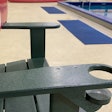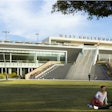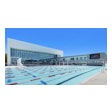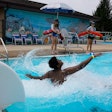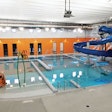After the wave of aquatic regulation changes that have taken effect over the last few months, commercial pool owners are likely looking forward to summer — their busiest time of year — as a chance to catch their collective breath.
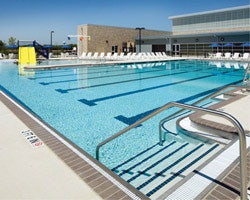 Pool operators have been slow to recognize the advantages of adding a variable frequency drive to a pool's filtration system.
Pool operators have been slow to recognize the advantages of adding a variable frequency drive to a pool's filtration system.Others will, amazingly, still have a taste for facility improvements — not so amazing, on second thought, when you consider the continuing escalation in energy costs. "People are looking for anything they can do to decrease operating costs, and one of the big ways they can make an impact is to save electricity," says Robert Kappel, executive board chair of the Professional Pool Operators of America. "And one of the best-kept secrets in the industry is variable frequency drives."
Variable frequency drives aren't so much a secret; their potential simply hasn't been fully realized by pool owners. Most commercial pool filtration systems operate using a two-speed or multi-speed pump. Multiple speeds allow a pool to maintain a water turnover rate consistent with minimum health department requirements but also filter faster if needed. "Every state is different," says Kappel. "The Model Aquatic Health Code wants to unify the country under one recommendation, but right now, it's two, four or six hours, depending on state and use."
Logically, running a pump at a lower speed doesn't seem like it would translate into energy savings, since the pump is consequently required to run for a longer period of time to filter the same amount of water, but the scientific calculations are more complicated. The process takes advantage of the affinity law, says Association of Pool and Spa Professionals technical committee chair Steve Barnes. For example, if a pump that turns 1,000 RPM at full speed moves 1,000 gallons per minute, when the speed is reduced to 500 RPM, it moves 500 gallons per minute. "The flow rate is proportional to the speed of the motor," explains Barnes. "But when you cut the speed in half, the pressure drops to one quarter. More importantly, the power drops to one eighth. So there's this huge decrease in energy use on the same pump running at half speed. To turn over the pool, you have to run it twice as long, but even running the pump twice as long, you're only using a quarter of the electricity."
While decreasing the turnover rate by half would not go over well with most local health departments, even small changes can have a large impact on energy use, which is where a variable frequency drive comes into play. A VFD works in conjunction with a pool's existing pump system, adjusting the speed of the motor in response to changing pool conditions, allowing the pump to run at more precise speeds and adjust as needed. "Let's say that a public pool needs a flow rate of 850 gallons per minute to meet the health code requirement, and it's running at 1,000 gallons a minute," explains Barnes. "That gives us 150 gallons per minute that we can slow down the pump. Any decrease gets you some savings by the affinity law. Some of these pumps are big — 25 horsepower that cost $10 an hour to run. If we can save $2.50 an hour, that adds up in a hurry."
It isn't just the savings in slowing down a pump to meet minimum requirements, says Kappel, who has been in the aquatics industry for more than 17 years. "Here's what a lot of people don't realize: A VFD is a more efficient way to power your pump than just a standard starter. Using the VFD instead of the throttle valve is really where the savings are."
A pool filter can only handle water up to a certain flow rate, though pumps are usually capable of producing a higher flow rate. "In most cases, a pool pump has a throttle valve used to moderate the amount of flow going through the system to match it to the capacity of the filter," says Kappel, adding that a VFD can slow the flow rate more efficiently. Instead of running the pump at full speed and choking off the water, the pump is slowed down to produce a flow rate that the filter can handle. "That right there, that little snapshot, can save a facility between 15 and 25 percent in energy costs by using the VFD instead of the throttle valve," Kappel says.
Pools that operate year-round can potentially recoup the cost of a VFD in less than a year, and though the payoff may take longer for a seasonal pool, the savings are, more often than not, still worth the investment.
Kappel also warns against installing a VFD without first checking its compatibility with the pump's motor. "You have to have what's called an inverter-rated pump motor, which means that the motor has extra insulation to handle the extra heat generated by the VFD."
The motor plate will have an insulation rating that tells an operator whether the motor is compatible with a VFD. Most newer motors should be, but even older models that aren't rated for them can be equipped, says Kappel. "Your motor might die a little bit sooner, and you have to be prepared for that; the good news is that motors aren't that expensive in the grand scheme of things."
With the potential cost savings offered by VFDs, it's a wonder they haven't become standard pool equipment. Part of the problem is that pool operators don't realize the full cost-saving potential. But even those that do still might run into trouble with local health inspectors, who are often wary of adding a device onto a pump that would allow it to run at less than the minimum flow rate. "There are ways that you can program a VFD so that it won't turn down past a certain rate," says Kappel. "You can protect it from going slower than health code allows."
Even with the safeguards available, Barnes believes that the issue of pool flow regulations itself deserves more scrutiny. "These turnover rates that were the rule of thumb coming out of the 1930s and '40s, when we first started putting equipment on commercial pools, have been the basis of health codes forever," he says. He's currently working in conjunction with the Southern Nevada Department of Health and NSF International on a plan to study the effect of turnover rate. "We're trying to put together a pilot run where we take a problem pool in Las Vegas and document that it's a problem keeping it clean and sanitized, and go in and document two, three, six weeks to get a good baseline of what that pool looks like after a party or something like that, all while the big pump is running at full speed."
After establishing a baseline, the pool's pump would be equipped with a VFD but still run at full speed for a few weeks before the flow rate was eventually reduced. The idea, Barnes says, is to differentiate between the cleaning power of the pool's filtration and chemical systems. "Pushing water through the filter is not what gets rid of the yuck that is in a pool. Those kinds of hazards are treated by chemicals because they're all too small to be captured by the filter. If a kid pees in the pool, it's going to go through the filter. It's a liquid just like water is; there's nothing to catch. Running the pump faster isn't going to make any difference."
The aim is to change industry thinking about the importance of turnover rate in pool cleaning and, eventually, create new industry standards "based on science, not what was decided in the 1920s," says Barnes. "Once we figure out that we're looking at chemicals more than filtration and separate that properly, then we can go in and really start saving money on electricity."
Energy efficiency is already on the legislative agenda in states like California, Florida and Arizona, though laws are aimed mostly at residential pools, which have even greater potential for energy savings. But both Barnes and Kappel believe that it won't be very long before the industry tackles energy use in commercial pools. Even so, with the savings pool operators stand to gain, there's no reason to wait until energy reform becomes compulsory to look into improved technology. "The time is past due," says Kappel. "If I operated a facility, I would be all over VFDs."














